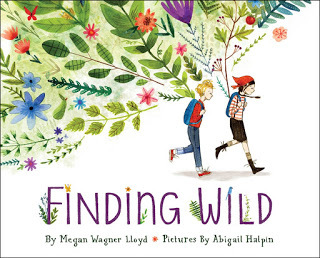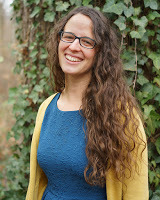Finding the Wild World
Guest Post by Megan Wagner Lloyd
Finding Wild follows two kid adventurers as they discover the beauty and wonder of the wild world. It asks the questions “What is wild? And where can you find it?” and invites readers on a journey to find the answers.

I’m so excited for teachers to share Finding Wild with their students. (And I’ve been thrilled to hear from teachers on Twitter who are doing just that!)
Three ways to use Finding Wild in the classroom:
1. As a nature-writing prompt
When and where have your students experienced the wild? Going camping, gardening, playing at the park, cloud gazing…kids have so many unique experiences with nature to share. I was thrilled to read this blog post from a teacher who plans to use Finding Wild as an introduction to a nature-writing unit with her high schoolers (more proof that picture books aren’t just for little ones!).
2. As a poetry mentor text
Finding Wild provides a great jumping off point to discuss metaphor, personification, and descriptive writing, and to encourage kids to include details from all five senses in their work. 3. In preparation for any kind of outdoor field trip or nature excursion
Reading Finding Wild before going out and about can encourage kids to pay attention to the natural wonders, big and small, all around them. I think it would be a great to share it before winter and spring breaks, too, to encourage kids to get outside and play! And then when everyone’s back in the classroom, teachers could set aside some time for everyone to share their wild observations.
 BIO: Megan Wagner Lloyd has been reading for (almost) as long as she can remember, and writing stories for just as long. Her debut picture book Finding Wild, illustrated by Abigail Halpin, was released by Knopf earlier this year. She lives with her family in the Washington D.C. area.
BIO: Megan Wagner Lloyd has been reading for (almost) as long as she can remember, and writing stories for just as long. Her debut picture book Finding Wild, illustrated by Abigail Halpin, was released by Knopf earlier this year. She lives with her family in the Washington D.C. area.
Learn more about Megan and her books at meganwagnerlloyd.com
Finding Wild follows two kid adventurers as they discover the beauty and wonder of the wild world. It asks the questions “What is wild? And where can you find it?” and invites readers on a journey to find the answers.

I’m so excited for teachers to share Finding Wild with their students. (And I’ve been thrilled to hear from teachers on Twitter who are doing just that!)
Three ways to use Finding Wild in the classroom:
1. As a nature-writing prompt
When and where have your students experienced the wild? Going camping, gardening, playing at the park, cloud gazing…kids have so many unique experiences with nature to share. I was thrilled to read this blog post from a teacher who plans to use Finding Wild as an introduction to a nature-writing unit with her high schoolers (more proof that picture books aren’t just for little ones!).
2. As a poetry mentor text
Finding Wild provides a great jumping off point to discuss metaphor, personification, and descriptive writing, and to encourage kids to include details from all five senses in their work. 3. In preparation for any kind of outdoor field trip or nature excursion
Reading Finding Wild before going out and about can encourage kids to pay attention to the natural wonders, big and small, all around them. I think it would be a great to share it before winter and spring breaks, too, to encourage kids to get outside and play! And then when everyone’s back in the classroom, teachers could set aside some time for everyone to share their wild observations.
 BIO: Megan Wagner Lloyd has been reading for (almost) as long as she can remember, and writing stories for just as long. Her debut picture book Finding Wild, illustrated by Abigail Halpin, was released by Knopf earlier this year. She lives with her family in the Washington D.C. area.
BIO: Megan Wagner Lloyd has been reading for (almost) as long as she can remember, and writing stories for just as long. Her debut picture book Finding Wild, illustrated by Abigail Halpin, was released by Knopf earlier this year. She lives with her family in the Washington D.C. area.Learn more about Megan and her books at meganwagnerlloyd.com
Published on November 07, 2016 14:00
No comments have been added yet.
Mary Quattlebaum's Blog
- Mary Quattlebaum's profile
- 22 followers
Mary Quattlebaum isn't a Goodreads Author
(yet),
but they
do have a blog,
so here are some recent posts imported from
their feed.



